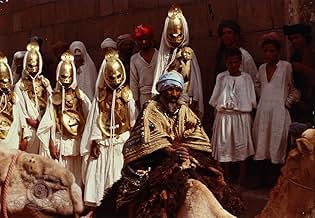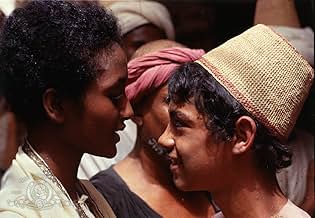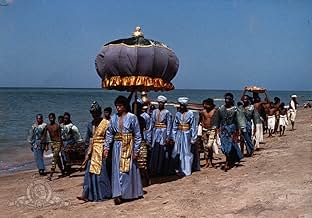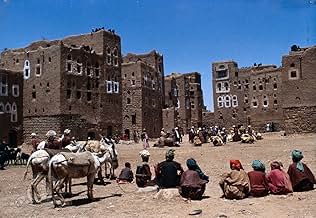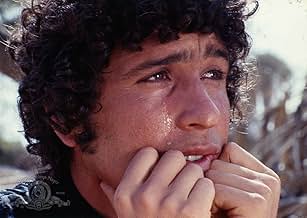ÉVALUATION IMDb
6,6/10
9,6 k
MA NOTE
Arabie ancienne. Une belle esclave choisit de faire d'un jeune homme son nouveau maître, mais elle est kidnappée et chacun doit rechercher l'autre. Des récits sont relatés dans des récits: a... Tout lireArabie ancienne. Une belle esclave choisit de faire d'un jeune homme son nouveau maître, mais elle est kidnappée et chacun doit rechercher l'autre. Des récits sont relatés dans des récits: amour, voyages et caprices du destin.Arabie ancienne. Une belle esclave choisit de faire d'un jeune homme son nouveau maître, mais elle est kidnappée et chacun doit rechercher l'autre. Des récits sont relatés dans des récits: amour, voyages et caprices du destin.
- Prix
- 1 victoire et 3 nominations au total
Tessa Bouché
- Aziza
- (as Tessa Bouche')
Margareth Clémenti
- Madre di Aziz
- (as Margaret Clementi)
Elisabetta Genovese
- Munis
- (as Elisabetta Vito Genovese)
Avis en vedette
This was the penultimate film of the great Italian director Pier Paolo Pasolini. It also concludes his "Trilogy of Life", based on medieval story collections (the others are "The Decameron" and "The Canterbury Tales"). Like the others in the series, this is a portmanteau film (i.e. the film is not just one story but several).
The film begins with a young man's search for his slave girl lover, who has been abducted. Along the way, several stories from "The Arabian Nights" are told.
The film has a very loose structure. There are stories, within stories, within stories. This can be quite confusing at times. It was filmed in Iran, Yemen and Nepal and the countries look absolutely spectacular. The main flaw of the film is that it does show signs of being hastily cut (Pasolini himself reduced the film by half an hour before general release, and there may have been cuts due to the censors). This often makes the film seem quite disjointed. One of the dominant themes in this film is love and sex, and yes, there is a lot of explicit nudity here.
The film touches on dreams, reality, deception, truth, freedom and slavery. While by no means perfect, there are times when the Pasolini's genius and humanity shines through.
The film begins with a young man's search for his slave girl lover, who has been abducted. Along the way, several stories from "The Arabian Nights" are told.
The film has a very loose structure. There are stories, within stories, within stories. This can be quite confusing at times. It was filmed in Iran, Yemen and Nepal and the countries look absolutely spectacular. The main flaw of the film is that it does show signs of being hastily cut (Pasolini himself reduced the film by half an hour before general release, and there may have been cuts due to the censors). This often makes the film seem quite disjointed. One of the dominant themes in this film is love and sex, and yes, there is a lot of explicit nudity here.
The film touches on dreams, reality, deception, truth, freedom and slavery. While by no means perfect, there are times when the Pasolini's genius and humanity shines through.
"Fiore delle mille e una notte" ,which won special prize at CANNES 1974 is the third part of what Pasolini called the trilogy of life which encompasses "il decameron" (1971) and" racconti di Canterbury" (1972). It's the most accessible of all Pasolini movies ,and weren't it for the numerous nudities,it would appeal to large audience.
This must be the script:it's much better than the two first films because the story is built à la Shéhérazade ,with plots ,subplots and subsubplots which fit into each other;and although sex is the main vector,it features enough twists to sustain the interest throughout.It does not forget magic (the segment which features Ninetto Davoli,Pasolini's favorite actor,uses a lot of symbols)and mystery (the adolescent who must be killed when he's fifteen ).Humor is less vulgar than in "di racconti di Canterbury" The little riddle "the aromatic grass of the fields" "the slit pomegranate" and "the inn of the warm welcome " is witty.
Little did we know that Pasolini would follow his trilogy of life with the most depressing work ever made :"Salo" (1975).
This must be the script:it's much better than the two first films because the story is built à la Shéhérazade ,with plots ,subplots and subsubplots which fit into each other;and although sex is the main vector,it features enough twists to sustain the interest throughout.It does not forget magic (the segment which features Ninetto Davoli,Pasolini's favorite actor,uses a lot of symbols)and mystery (the adolescent who must be killed when he's fifteen ).Humor is less vulgar than in "di racconti di Canterbury" The little riddle "the aromatic grass of the fields" "the slit pomegranate" and "the inn of the warm welcome " is witty.
Little did we know that Pasolini would follow his trilogy of life with the most depressing work ever made :"Salo" (1975).
This very unique rendering of the Arabian Nights was filmed in natural locations in places as diverse as Ethiopia, Yemen, Iran and Nepal. The beauty of the landscapes is breathtaking, and makes the film an incredible voyage into time and space.
Please note that this movie is an explicitly erotic one, but one tends to forget that the original Arabian Nights were very much so, and not fairy tales for children. It is certainly difficult to make an erotic masterpiece, as sexual content does not make a movie better. It rather tends generally to get crassly exploitative, and rarely beautiful. There is plenty of sex in this movie, but it is depicted in a natural, feel-good and intelligent way that is rarely to be found elsewhere.
By the way, this movie should be seen again at the light of nowadays controversies. The Muslim world was far from always having been puritanical, and the sensual poetry that is rendered here is not Pasolini's invention. It is the faithful reflection of a hedonistic Orient that produced for instance poet Omar Khayyam as well as the original Arabian Nights. It is also a film about love, the most gripping part being the tragic and mysterious tale of Aziz and Aziza.
Don't expect any Aladdin or Ali Baba stuff here, you already figured this out. Anyway, it would be impossible to make a complete film version of the Arabian Nights, so this work just shows a few excerpts combined together (the Italian title is in in fact "the flower of the Arabian Nights"). However, the trend of the tales is respected in the sense that all the stories are interwoven into one another and eventually come back to the original plot.
The atmosphere of ancient Orient is rendered in a style that is lightyears away from usual clichés, and in an incredibly authentic and physical way. At times, you get the illusion that you feel the blazing sun on your skin, that you can smell the exotic vegetation, the sand, the noisy bazaars full of spices. There are a few flaws though : visible cutting, unadapted stances of classical music. The use of non professional actors was common for Pasolini, and gives a pleasant feeling of naive freshness.
The movie is probably Pasolini's best, and belongs to the "trilogy of Life" that included "the Decameron" and "the Canterbury tales", also literature classics. But much more than the two others, this movie is an ode to life. Hard to suspect that Pasolini's last work would be an ode to death. "Arabian Nights" belongs to the golden age of Italian cinema, that was incredibly prolific and innovative in the sixties and seventies.
All in all, not a family movie, but if you are curious and open-minded, get ready for a beautiful journey.
Please note that this movie is an explicitly erotic one, but one tends to forget that the original Arabian Nights were very much so, and not fairy tales for children. It is certainly difficult to make an erotic masterpiece, as sexual content does not make a movie better. It rather tends generally to get crassly exploitative, and rarely beautiful. There is plenty of sex in this movie, but it is depicted in a natural, feel-good and intelligent way that is rarely to be found elsewhere.
By the way, this movie should be seen again at the light of nowadays controversies. The Muslim world was far from always having been puritanical, and the sensual poetry that is rendered here is not Pasolini's invention. It is the faithful reflection of a hedonistic Orient that produced for instance poet Omar Khayyam as well as the original Arabian Nights. It is also a film about love, the most gripping part being the tragic and mysterious tale of Aziz and Aziza.
Don't expect any Aladdin or Ali Baba stuff here, you already figured this out. Anyway, it would be impossible to make a complete film version of the Arabian Nights, so this work just shows a few excerpts combined together (the Italian title is in in fact "the flower of the Arabian Nights"). However, the trend of the tales is respected in the sense that all the stories are interwoven into one another and eventually come back to the original plot.
The atmosphere of ancient Orient is rendered in a style that is lightyears away from usual clichés, and in an incredibly authentic and physical way. At times, you get the illusion that you feel the blazing sun on your skin, that you can smell the exotic vegetation, the sand, the noisy bazaars full of spices. There are a few flaws though : visible cutting, unadapted stances of classical music. The use of non professional actors was common for Pasolini, and gives a pleasant feeling of naive freshness.
The movie is probably Pasolini's best, and belongs to the "trilogy of Life" that included "the Decameron" and "the Canterbury tales", also literature classics. But much more than the two others, this movie is an ode to life. Hard to suspect that Pasolini's last work would be an ode to death. "Arabian Nights" belongs to the golden age of Italian cinema, that was incredibly prolific and innovative in the sixties and seventies.
All in all, not a family movie, but if you are curious and open-minded, get ready for a beautiful journey.
Pasolini is a wonderful, wonderful adventure. Welcoming him into your heart is not without cost; he's a friend who is brilliant on one side and captive to banality on the other.
The bad? Well, its tolerable for me because it is so flamboyantly obvious. The man has a triple curse: he is outrageously gay, he is insufferably Italian and (perhaps because of these two) he has excessively simpleminded storytelling skills. The stories here in their individual content have juvenile dynamics. The way the emotions are handled is comically simpleminded.
That's in the nature of the stories of course, but our man here takes them seriously, so overlain on this is his own sexual nature. These stories are, some of them, erotic in nature and all of them have desire as the driver. Among the various stories, he's chosen these and that's fine enough. The original stories were distributed in places all over the Islamic world, a huge reach, but all of them which included sex joked about the dissonance between Islmac attitudes towards sex and the actual lives of folks within.
But its rather interesting actually watching how his own predilections enter the story. Most of the men here are slaves to their own desires. But those desires are all in the stories skipping over the most superficial of erotic notions. A teenage boy awakes and finds an unconscious teenage girl next to him. He has sex with her. This is equated to "falling in love." It happens over and over and if you encounter these stories in text, its part of the fun.
But see how Pasolini himself enters the story in how he chooses to portray the erotic content. Nudity and youth stand for the erotic, especially the nude boy. When sex is depicted (less than you would expect from the stories) its amazing wooden, mannikins. I suppose if you made some still images of parts of this it would be erotic, but repeatedly seeing the male member of a cartoon tells me that director has the same foibles as the characters we see.
The Good? Well there's more than enough of that to make up for the sexual inadequacies of that part of the world.
There's the absolute beauty of the thing cinematically. It isn't fully cinematic in motion, since Pasolini has no notion of how things flow, what the rhythms of things are. But each shot is fulfilling and some are absolutely breathtaking. He doesn't have any static tableaux like the striking ones in "Matthew," but the visual elegance is erotic in itself. Its a sort of continuous penis shot of life, and you'll find the beauty of the places erotic in their own ways, And then there's the way the stories are crafted.
Yes they are cartoonish. Yes, they have execrable pacing, almost as if they were found objects and put in inappropriate boxes. But the way they are tied one to another is nothing short of brilliant. If we had none of the beauty, and none of the amusement of watching an Italian fop struggle on screen, we'd still have this. And its great.
There isn't any one mechanism that links the stories; there may be a dozen. There isn't any sense to about half of them, and that's part of the miracle. Sometimes they are inside one another, but sometimes they walk through each other. Sometimes it is the same place of extras. Sometimes a repeated situation; "don't eat from that plate." Sometimes it is simply a segue that has no narrative connection at all but just seems nested or siblinged in some way. Its "Sarogossa Manuscript" with fun and beauty.
I must say that one story really is perfect. It alone has two really beautiful women acting erotically. It has expert pacing. It is funny: laugh out loud funny. And it has a punishment that is one of the most arresting images you'll see if you are a guy. Plus it has a framing story that makes me think it was the first one adapted and filmed.
Ted's Evaluation -- 3 of 3: Worth watching.
The bad? Well, its tolerable for me because it is so flamboyantly obvious. The man has a triple curse: he is outrageously gay, he is insufferably Italian and (perhaps because of these two) he has excessively simpleminded storytelling skills. The stories here in their individual content have juvenile dynamics. The way the emotions are handled is comically simpleminded.
That's in the nature of the stories of course, but our man here takes them seriously, so overlain on this is his own sexual nature. These stories are, some of them, erotic in nature and all of them have desire as the driver. Among the various stories, he's chosen these and that's fine enough. The original stories were distributed in places all over the Islamic world, a huge reach, but all of them which included sex joked about the dissonance between Islmac attitudes towards sex and the actual lives of folks within.
But its rather interesting actually watching how his own predilections enter the story. Most of the men here are slaves to their own desires. But those desires are all in the stories skipping over the most superficial of erotic notions. A teenage boy awakes and finds an unconscious teenage girl next to him. He has sex with her. This is equated to "falling in love." It happens over and over and if you encounter these stories in text, its part of the fun.
But see how Pasolini himself enters the story in how he chooses to portray the erotic content. Nudity and youth stand for the erotic, especially the nude boy. When sex is depicted (less than you would expect from the stories) its amazing wooden, mannikins. I suppose if you made some still images of parts of this it would be erotic, but repeatedly seeing the male member of a cartoon tells me that director has the same foibles as the characters we see.
The Good? Well there's more than enough of that to make up for the sexual inadequacies of that part of the world.
There's the absolute beauty of the thing cinematically. It isn't fully cinematic in motion, since Pasolini has no notion of how things flow, what the rhythms of things are. But each shot is fulfilling and some are absolutely breathtaking. He doesn't have any static tableaux like the striking ones in "Matthew," but the visual elegance is erotic in itself. Its a sort of continuous penis shot of life, and you'll find the beauty of the places erotic in their own ways, And then there's the way the stories are crafted.
Yes they are cartoonish. Yes, they have execrable pacing, almost as if they were found objects and put in inappropriate boxes. But the way they are tied one to another is nothing short of brilliant. If we had none of the beauty, and none of the amusement of watching an Italian fop struggle on screen, we'd still have this. And its great.
There isn't any one mechanism that links the stories; there may be a dozen. There isn't any sense to about half of them, and that's part of the miracle. Sometimes they are inside one another, but sometimes they walk through each other. Sometimes it is the same place of extras. Sometimes a repeated situation; "don't eat from that plate." Sometimes it is simply a segue that has no narrative connection at all but just seems nested or siblinged in some way. Its "Sarogossa Manuscript" with fun and beauty.
I must say that one story really is perfect. It alone has two really beautiful women acting erotically. It has expert pacing. It is funny: laugh out loud funny. And it has a punishment that is one of the most arresting images you'll see if you are a guy. Plus it has a framing story that makes me think it was the first one adapted and filmed.
Ted's Evaluation -- 3 of 3: Worth watching.
Fun to see the comments at two extreme posts. There are things like durian and cheese, either you love it, or you hate it! So below is just my personal opinion and you absolutely don't need to agree with me!
It is true that the characters are quite caricatural, but the movie is about one thousand and one nights - it is about fantasies! Honestly i don't ever find the "dreams" typical of hollywoodian movies more appealing. it is just a matter of taste. in fact, through exaggerations, Pasolini let human strengthens and weaknesses magnified and incarnated in the characters. in a way, they are like cartoon characters. Can we call that bad acting? it is just a style of interpretation. Oh, only if we had the innocence like the actors and actress in the movie ... in fact, somehow i found a bit of resemblance (or to the opposite of it!) in these characters to people i know. only if you observe, man! I especially love the story about Aziz and Aziza...
It is above all a movie about love - and there comes sex naturally, and the jealousy, pain, loyalty, betrayal, etc. Even between the "owner" and the "slave", there was absolutely no slavery involves, but just love! well an exchange took place in the market, but that only showed that the slave was actually free. Pasolini didn't have an obsession for the female body which is usually the case in most movies. Is there anything wrong about that? Or are we just too accustomed to female nudity so we always expect it and we become annoyed about male nudity too easily? Both can be beautiful and deserve the same attention from the camera and the audience.
Talking about female vs. male in the movies, i constantly feel that Pasolini pictured man as a simple but too simple (even stupid) creature, while woman as complex and too complex (either a saint or perversed) when it comes to love. But again, it's about fairy tales. Only if it were true, life would be so much easier!
There were poems cited in almost every story and this was one of the most fascinating elements in the movie as well. you may call it erotic, but look at it another way round, who doesn't want his/her own sex and love life to be as poetic and beautiful. I see the humour in the movie with the same lens.
I was also amazed by the flow of the story line - story within a story, and then a personage in the story starts to tell another story... it can be confusing at first, but as the story flows it all became clearer, and at the end, i was simply amazed. or thanks to the DVD technology too, imagine 30 years back when u had to and could only watch it in one go in a cinema!
It is true that the characters are quite caricatural, but the movie is about one thousand and one nights - it is about fantasies! Honestly i don't ever find the "dreams" typical of hollywoodian movies more appealing. it is just a matter of taste. in fact, through exaggerations, Pasolini let human strengthens and weaknesses magnified and incarnated in the characters. in a way, they are like cartoon characters. Can we call that bad acting? it is just a style of interpretation. Oh, only if we had the innocence like the actors and actress in the movie ... in fact, somehow i found a bit of resemblance (or to the opposite of it!) in these characters to people i know. only if you observe, man! I especially love the story about Aziz and Aziza...
It is above all a movie about love - and there comes sex naturally, and the jealousy, pain, loyalty, betrayal, etc. Even between the "owner" and the "slave", there was absolutely no slavery involves, but just love! well an exchange took place in the market, but that only showed that the slave was actually free. Pasolini didn't have an obsession for the female body which is usually the case in most movies. Is there anything wrong about that? Or are we just too accustomed to female nudity so we always expect it and we become annoyed about male nudity too easily? Both can be beautiful and deserve the same attention from the camera and the audience.
Talking about female vs. male in the movies, i constantly feel that Pasolini pictured man as a simple but too simple (even stupid) creature, while woman as complex and too complex (either a saint or perversed) when it comes to love. But again, it's about fairy tales. Only if it were true, life would be so much easier!
There were poems cited in almost every story and this was one of the most fascinating elements in the movie as well. you may call it erotic, but look at it another way round, who doesn't want his/her own sex and love life to be as poetic and beautiful. I see the humour in the movie with the same lens.
I was also amazed by the flow of the story line - story within a story, and then a personage in the story starts to tell another story... it can be confusing at first, but as the story flows it all became clearer, and at the end, i was simply amazed. or thanks to the DVD technology too, imagine 30 years back when u had to and could only watch it in one go in a cinema!
Le saviez-vous
- AnecdotesThis film is the final entry in director Pier Paolo Pasolini's "Trilogy of Life," following Il Decameron (1971) and I racconti di Canterbury (1972).
- GaffesWhen the chimpanzee is writing, it's clearly visible that it's not actually the chimp writing but an actor wearing a glove made to look like the chimp's hand.
- Générique farfelu"Truth lies not in one dream, but in many." - Arabian Nights
- Autres versionsThe 1990 Water Bearer Films video release (WBF 8001) is marked "Original Uncut Version" with a runtime of 133 min. It is rated X.
- ConnexionsEdited into Porno & libertà (2016)
Meilleurs choix
Connectez-vous pour évaluer et surveiller les recommandations personnalisées
- How long is Arabian Nights?Propulsé par Alexa
Détails
- Date de sortie
- Pays d’origine
- Langues
- Aussi connu sous le nom de
- Arabian Nights
- Lieux de tournage
- Mesjed-e-Imam, Esfahan, Iran(Zumurrud's palace)
- sociétés de production
- Consultez plus de crédits d'entreprise sur IMDbPro
Box-office
- Brut – à l'échelle mondiale
- 755 $ US
- Durée2 heures 10 minutes
- Mixage
- Rapport de forme
- 1.85 : 1
Contribuer à cette page
Suggérer une modification ou ajouter du contenu manquant

Lacune principale
What is the Japanese language plot outline for Il fiore delle mille e una notte (1974)?
Répondre


